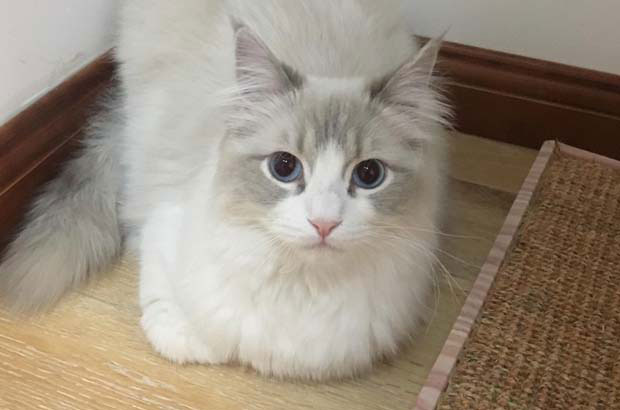Ragdoll Cat: The “Little Fairy” of the Cat World (2)
The causes of white spots and their genetic laws have always been of concern to breeders. It is currently believed that white spots are controlled by the white spot gene, which prevents the hair in a certain area from synthesizing any pigment, thus appearing white. Through long-term observation, it is currently believed that the white spots in Ragdoll Cats are controlled by a single gene, and that the white spot gene has a total of three alleles, two of which can produce white spots, namely S1 and S2: S1 produces smaller white spots, while S2 produces larger white spots. The third allele, s, cannot produce white spots. The size of the white spots of the alleles has an additive effect. Because there are three alleles, and each gene must have two copies, there are six combinations. The corresponding relationship between genotype, pattern type, and Ragdoll Cat’s appearance is as follows:
Secondly, let’s take a look at the color classification of Ragdoll Cats. The color classification here refers to the color of the key color area, which can be observed on the ears and tail.
1. The seal
color is darker, and the key color area is dark brown like seal skin, which belongs to the warm color system.

2. The blue
color is lighter, and the key color area presents an elegant gray-blue, which belongs to the cold color system.
3. Rare color
chocolate color: light brown system. Lilac: light gray-purple system. Red: orange-red system. Cream color: light yellow system.
In fact, all these six coat colors are controlled by three genes, namely the red gene, the brown gene and the dilution gene. The red gene is responsible for producing pheomelanin, which makes the coat color appear orange-yellow, while the brown gene is responsible for producing eumelanin, which makes the coat color appear black. However, the brown gene mutated in cats, forming two new variants, called chocolate genotype (b) and cinnamon genotype (b1). These two genotypes can also produce eumelanin, but their concentration is lower, so the color looks lighter.
Finally, the classification of ragdoll cats’ markings, which can be combined with any pattern and color.
1. Bobcat pattern (also called tiger pattern)
has a striped tiger pattern like a lynx. It is attached to the key color area and belongs to the pattern type incidental pattern. The ragdoll cat with lynx pattern has white ears.
2. The tortoiseshell pattern
is also called tortoise shell. It has mottled color blocks, similar to the tortoiseshell pattern. It is attached to the key color area and is a brindle-type incidental pattern.
3. The mottled color blocks of the bobcat tortoiseshell
pattern have striped tiger stripes. It is attached to the key color area and is a brindle-type incidental pattern.
The solid color gene of the ragdoll cat controls the presence or absence of annular stripes on the hair. The solid color gene is an autosomal recessive gene with two alleles: the wild type (A) causes the hair shaft to produce annular stripes; the mutant type (a) causes the pigment particles to be evenly distributed throughout the hair shaft. Among them, a is a recessive allele and is suppressed by A. Only when the ragdoll cat carries two recessive alleles (a/a) will it show a solid color effect (no tiger stripe pattern). However, the red gene can suppress the solid color gene, so a red key color ragdoll cat without tiger stripes will never exist.
In addition, the standard for naming ragdoll cats is to name them in the order of color + stripes + pattern, such as seal, lynx, glove, ragdoll cat, etc. But to be honest, I can’t really tell the classification of ragdolls, I just know that they are good-looking, they are all so beautiful!
Leave a Reply